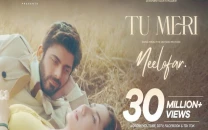Styled to the beat
Four music videos that defined fashion

For those who insist that music is a form of self-expression, the music video may be the ultimate canvas - an art form where sound and sight converge in a manner that can captivate and inspire in equal measure. Over the years, it has not merely reflected trends, but often created them, shaping how we view fashion and how we experience culture.
As is often the case with cultural products, it is only in retrospect that we look back at certain music videos and realise that their influence far exceeds the realm of music. Some of them have been powerful on a global scale and have, in fact, altered the very fabric of fashion itself, dictating what we wear, how we wear it, and perhaps most importantly, why we wear it. Here are four seminal moments from music videos that have transformed fashion in ways that still resonate with us today.
Madonna – 'Like a Virgin' (1984)
In the mid-1980s, Madonna was not just a pop star; she was a force - a woman who understood, perhaps better than anyone before her, how to use fashion as a storytelling device. The Like a Virgin video introduced the world to a carefully curated image of innocence and rebellion, a dichotomy that would define her career and, by extension, an era of style.
The lace gloves, the tutu skirt, the corset - each piece was not merely worn, but embodied the idea of femininity as something to be both cherished and subverted. The ensemble was at once delicate and fierce, a perfect metaphor for Madonna herself, who would soon be elevated to global icon status.
The significance of this video cannot be overstated. Madonna proved that fashion could be as transformative as music, and in doing so, she became the epitome of '80s fashion. The ones invested in histories of fashion will often find their eyes straining on red carpets today, suspecting Madonna's influence in a host of collections, from Jean-Paul Gaultier's sculptural corsets to Vivienne Westwood's punk-infused collections.
Beyoncé – 'Single Ladies' (2008)
In many ways, Beyoncé's leotard in Single Ladies was as much a cultural symbol as it was a fashion item. For instance, its brazenness had little utility as the latter in a dressing landscape such as Pakistan. In other geographies, it was simple, it was sleek, and it was "empowered" - reflecting a political milieu when women were beginning to reclaim agency in every part of their lives.
Beyoncé's look, paired with a relentless, almost hypnotic dance routine, made the leotard an instant icon. The black bodysuit, the pointed heels, the slick ponytail - all became shorthand for confidence and self-assurance, each element carefully chosen to exude power. This look, now ubiquitous in athleisure and pop culture, continues to inspire countless iterations on runways, in street style, and in every corner of fashion.
2008 was also witness to a budding digital age, a porous membrane between yesterday's inhibitions and tomorrow's sensitivities. Beyoncé invited the American woman to embrace her independence and a self-preserved outlook on relationships. Naturally, for women who could not or would not don that form-fitting leotard, it meant replicating the singer's electric choreography alone in a bedroom and wondering what was amiss. (The leotard, duh.)
Kurt Cobain – 'Smells Like Teen Spirit' (1991)
While the late 1980s were all about excess - shoulder pads, big hair, sequins - the early '90s ushered in a quieter, more rebellious sensibility. Kurt Cobain's grunge aesthetic, as immortalised in the video for Smells Like Teen Spirit, was nothing short of revolutionary.
Cobain's look was decidedly unpolished: flannel shirts, distressed jeans, and tattered sweaters were all indicative of a generation that was, in many ways, rebelling against the glamour of the decades before. But the genius of Cobain's style lies in its anti-fashion ethos. It was the perfect antidote to the glossiness of the '80s, and it resonated on a profound level with those who sought to reclaim fashion as something authentic rather than aspirational.
The sheer power of Smells Like Teen Spirit lay in its rawness, in its refusal to be glamorous or even particularly "stylish." The flannel shirt, now an enduring symbol of grunge, became the cornerstone of a movement - one that would influence not just music but also high fashion, where luxury designers like Marc Jacobs and Alexander Wang embraced the distressed and undone aesthetic in their collections. Off the runway, even where Cobain's celebrity is only vaguely present if at all, his grunge ensemble continues to live on by virtue of being doable and carefree.
Lady Gaga – 'Bad Romance' (2009)
With how much the music and aesthetic scene has begun to revolve around the near-mythical image of an internet-obsessed Gen Z, remembering Lady Gaga is itself a test. Are you an indifferent consumer of her A Star Is Born era? Or an unsparing critic still bemoaning the narrative ambitions of Joker: Folie à Deux? Amidst the Joker buzz, it's also quite possible that you only distantly recall that the singer-turned-actor's proud digital fandom dub themselves little monsters.
But you need not be a little monster to appreciate Bad Romance's entry in the entertainment sphere as the happy marriage of music and fashion. 2009's Gaga was the perfect mainstream rebel. True to that script, the electro-infused dance-pop track came with a music video maxed out on avant-garde couture and dark fantasy.
From Alexander McQueen armadillo boots to Balenciaga jackets, every piece in the video was carefully chosen to shock, to provoke, and above all, to mesmerise. As kids these days say it, when it came to fusing surrealism with couture, Lady Gaga ate and left no crumbs.



















COMMENTS
Comments are moderated and generally will be posted if they are on-topic and not abusive.
For more information, please see our Comments FAQ